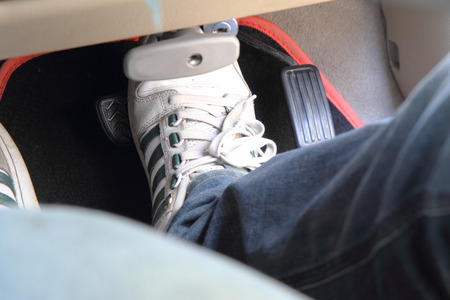First Update on Manufacturers’ Progress on AEB System Installations
January 22, 2018 | Category: Automobile Accidents | ShareThe National Highway Traffic Safety Administration (NHTSA) and the Insurance Institute for Highway Safety (IIHS) announced the first update of manufacturer progress toward equipping every new vehicle with automatic emergency braking, a crash avoidance technology.
 The December 21, 2017 NHTSA/IIHS press release said that, “Twenty automakers pledged to voluntarily equip virtually all new passenger vehicles by September 1, 2022, with a low-speed AEB system that includes forward collision warning (FCW) technology proven to help prevent and mitigate front-to-rear crashes. Four of 20 automakers (Toyota, GM, Honda and Mercedes Benz) report that automatic emergency braking (AEB) is standard on more than half of their 2017 model year vehicles. Another five automakers (Tesla, Audi, Volvo, BMW and Subaru) report that more than 30 percent of vehicles they produced in 2017 were equipped with AEB.”
The December 21, 2017 NHTSA/IIHS press release said that, “Twenty automakers pledged to voluntarily equip virtually all new passenger vehicles by September 1, 2022, with a low-speed AEB system that includes forward collision warning (FCW) technology proven to help prevent and mitigate front-to-rear crashes. Four of 20 automakers (Toyota, GM, Honda and Mercedes Benz) report that automatic emergency braking (AEB) is standard on more than half of their 2017 model year vehicles. Another five automakers (Tesla, Audi, Volvo, BMW and Subaru) report that more than 30 percent of vehicles they produced in 2017 were equipped with AEB.”
“The growing number of vehicles offering automated emergency braking is good news for America’s motorists and passengers,” says U.S. Department of Transportation Secretary Elaine L. Chao. “With each model year, manufacturers will increasingly utilize technology to allow vehicles to ‘see’ the world around them and navigate it more safely.”
What are automatic emergency braking systems?
IIHS says that AEB systems help prevent crashes or reduce their severity by applying the brakes for the driver. The systems use on-vehicle sensors such as radar, cameras or lasers to detect an imminent crash, warn the driver, and apply the brakes if the driver does not take sufficient action quickly enough.
Two AEB systems, crash imminent braking (CIB) and dynamic brake support (DBS), have been available on some vehicle models in the United States since 2006, says Safercar.gov.
- CIB: If the driver does not take any action to avoid the crash, CIB automatically applies the vehicle’s brakes to slow or stop the car, avoiding the crash or reducing its severity.
- DBS: If the driver brakes but not hard enough to avoid the crash, DBS automatically supplements the driver’s braking in an effort to avoid the crash.
What kind of safety benefits can be expected from AEB?
IIHS research shows that AEB systems meeting the commitment would reduce rear-end crashes by 40 percent. IIHS estimates that by 2025, the earliest year NHTSA believes it could realistically implement a regulatory requirement for AEB, the manufacturers’ commitment will prevent 28,000 crashes and 12,000 injuries.
AEB provides protection against distracted driving.
Lifewire.com reported in July 2017 that if a driver remains perfectly vigilant at all times, he/she will not ever notice that the vehicle even has an automatic braking system. However, technical experts agree that automatic brakes can save lives if a driver ever suffers from a momentary lapse in concentration. Automatic braking systems are primarily designed as a safeguard against distracted driving, and the technology can also save lives if a driver happens to fall asleep behind the wheel.
Automatic car emergency brakes are not necessarily designed to prevent crashes, according to a study by AAA (American Automobile Association). There are some systems that merely reduce the severity of accidents. The AAA study found that systems designed to prevent crashes reduced vehicle speeds once they were activated by nearly twice that of those designed to lessen crash severity. “Yet, more than two-thirds of U.S. drivers familiar with the technology believe that automatic emergency brakes are designed to avoid crashes without driver intervention,” said John Nielsen, AAA’s managing director of automotive engineering and repair. “The reality is that today’s systems vary greatly in performance, and many are not designed to stop a moving car.” This lack of understanding could lead consumers to place too much confidence in their automated technology, and as a result, take greater risks while driving.
“If you have been injured in an accident involving a negligent driver, contact the experienced injury attorneys at Spivey Law Firm, Personal Injury Attorneys, P.A. to determine your rights,” said Fort Myers Accident Attorney, Randall Spivey.
Fort Myers Accident Attorney,Randall L. Spivey is a Board Certified Trial Attorney – the highest recognition for competence bestowed by the Florida Bar and a distinction earned by just one (1%) percent of Florida attorneys. He has handled over 2,000 personal injury and wrongful death cases throughout Florida. For a free and confidential consultation to discuss your legal rights, contact the Spivey Law Firm, Personal Injury Attorneys, P.A., in Lee County at 239.337.7483 or toll free at 1.888.477.4839, or by email to Randall@SpiveyLaw.com. Visit SpiveyLaw.com for more information. You can contact Spivey Law Firm, Personal Injury Attorneys, P.A.in Charlotte County at 941.764.7748 and in Collier County 239.793.7748.

